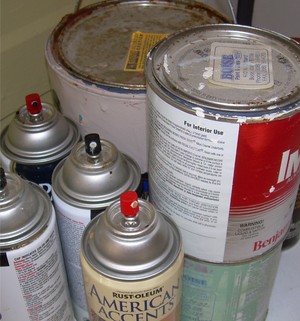Paint is a product that’s found almost everywhere you look. It is used to protect structures from the weather and metals from rust, but also to add a little variety and interest to our surroundings. Paint is such a common household product that every household has generated paint waste and by-products at one point or another. According to CIWMB (California Integrated Waste Management Board), the average household has between 1 to 3 gallons of paint stored somewhere on their property.
The chemistry of paint
So what’s in paint that makes it harmful to the environment?
Paints are made of four basic components. The resin is the main ingredient of paint, and is the coating that forms on the items being painted. Resins can either be synthetic, or made of linseed oil or acrylic. These are usually nontoxic. Pigment is what provides the color. These days, pigments are mostly non toxic, though some of the more brightly colored paints can contain heavy metals such as cadmium or chromium. Solvents are what keeps the paint liquid. In latex plaint, the solvent is water, but oil paints contain a distilled petroleum derivative which can include hazardous ingredients. Additives are the final component and can include such things as mold inhibitors, thickeners, and preservatives.
The metal in the pigments and the petroleum based solvents are what make paint so harmful to the environment. Latex and oil based paint can harm wildlife and pollute food sources if dumped onto the ground or into a storm drain. Pouring extra paint down the toilet or sink can impact sewage treatment plants by disturbing microbes and increasing filtering time. Even cans thrown in the trash can spill over and ruin what might have been good recyclable materials. In addition, the solvent in oil paint is high flammable and can be toxic if inhaled.
How to recycle or dispose of Latex or Acrylic Paint
When it comes to any type of paint, the best policy is to only buy what you need, and use it up.
If you have less than a pint, why not keep on painting! Give the wall a third coat and use up every last bit left in the can. Left over paint can also be used it for crafting, wood furniture, or on the walls of storeroom or closet.. Try combining it with other colors and use as a prime coat or to paint something that really doesn’t matter. If you have at least a third of a gallon of paint or more, donate it to a local theater arts group, school, church, community center, shelter or a Habitat for Humanity Project. You can even call around to neighbors or organize a neighborhood paint exchange.
While water based paints such as latex and acrylics are actually pretty safe to dispose of, certain states do treat latex paint as hazardous material. However, all municipalities seem to agree that once latex paint has dried up in the container, it can be safely tossed in the garbage can. If the paint is still in liquid form, it needs to be solidified before disposal.
In California, it is illegal for residents to dry up their own liquid paint for disposal and the paint must be brought to a Hazardous Waste Collection Site instead. Other states instruct residents not to leave latex paint at Haz Mat sites, but to solidify leftover latex paint themselves. This is done by leaving the open can outside to dry, away from kids and pets or by adding a few cups of kitty litter. Once dried, the paint cans can be tossed in the garbage with the lids off.
Since rules regarding latex paint disposal seem to vary from state to state, it’s best to contact your city’s division of Public Works or the trash company for guidelines.
How to recycle or dispose of Oil Paint
Oil paint in liquid form is considered hazardous waste for several reasons. The petroleum solvents are highly flammable, and the other components can be toxic to inhale. As with the latex paint, the best solution is to buy only what you need and use it all up.
If you don’t have another use for the paint and have 1/3 of a can or more, leave it in the original container and donate it to one of the charities listed about. Oil paint is great for to covering graffiti and can be donated to the police department or Parks and Rec graffiti teams.
Like latex paint, once the oil paint has dried, it can be safely tossed in the trash can with lids left off. And, since rules for solidifying household paint vary from state to state, It’s always best to check with your local Public Works to learn how liquid paint disposal is managed in your community.
Other Precautions
If you have old paint in your basement, it will have be treated differently. Many paints made prior to 1991 had Mercury additives to slow down the growth of mold. This paint is fine for exterior use, but is harmful if used indoors. If you plan to donate a can of 16 year old paint, write on the outside of the can “Exterior Use Only” and let the recipient know the reason why.
Paints purchased before 1977 may contain lead in the pigments. Lead is poisonous and this old paint shouldn’t be used for any reason. All old paints in your home should automatically be brought to a Hazardous Waste Collection Site.
Spray paint can also contain solvents and propellants which are harmful to the environment. Cans that still contain paint must be taken to a Hazardous Waste Canter for disposal. Empty cans that do not discharge paint or propellant can be thrown safely in the garbage can.
Recycling the Empty Cans
Some recycling centers will recycle empty paint cans. Some will accept cans with dried on paint, while others will only take cans that are both completely empty and thoroughly rinsed of paint. Since paint does tend to dry on the rims and sides, I merely transfer the newly opened paint into a reusable plastic container with a snap on lid. Once transferred, the metal can then easily be rinsed and placed in the recycling bin. Cleaning the plastic tub for reuse is a snap, since dried paint will “pop” right off the flexible sides. Again, the rules seem to differ from area to area regarding paint container recycling; call your local recycling center for their guidelines.
If you plan on keeping paint around the house for touch ups and future projects, it can be kept usable by fastening the lid securely and storing it upside down. And, when it’s finally time to dispose of it, follow the guidelines of your community for solidifying the paint and getting rid of it safely.



